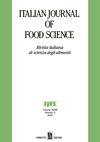在植物栽培过程中使用水杨酸作为改善其代谢谱和有益健康效应的策略
IF 3.3
4区 农林科学
Q2 FOOD SCIENCE & TECHNOLOGY
引用次数: 3
摘要
在植物栽培过程中,化学激发剂被应用于土壤、水培溶液或喷洒在叶片上,以诱导生理变化和刺激生物活性化合物的产生。水杨酸(Salicylic acid, SA)是一种存在于植物体内的酚类化合物,具有多种功能,包括刺激植物生长和诱导植物在逆境条件下的防御反应。最近,由于越来越多的研究表明其在水果、蔬菜和草药中对诱导植物化学物质(主要是酚类化合物、生物碱、皂苷、类胡萝卜素等)的积极作用,使用SA作为激发剂引起了很大的兴趣。经SA处理的植物材料的健康益处主要是通过2,2'-氮唑-(3-乙基苯并噻唑-6-磺酸)(ABTS)和2,2-二苯基-1-吡啶肼(DPPH)测定其抗氧化能力和体外抗炎性能,以及体内研究评估其降血糖、降血脂和肾脏保护性能。因此,在不同植物的栽培过程中外源施用SA可能是增加其经济价值的一种选择,并可能成为设计生物活性化合物生产标准化程序的基础。本文章由计算机程序翻译,如有差异,请以英文原文为准。
Use of salicylic acid during cultivation of plants as a strategy to improve its metabolite profile and beneficial health effects
Chemical elicitors in plants during cultivation have been applied in soil, hydroponic solutions, or sprayed on the leaves to induce physiological changes and stimulate the production of bioactive compounds. Salicylic acid (SA) is a phenolic compound present in plants with multiple functions, including stimulus of plant growth and induction of plant defense responses under conditions of stress. Recently, the use of SA as elicitor has generated much interest, due to the growing number of studies demonstrating its positive effects in fruits, vegetables, and herbs on the induction of phytochemicals, mainly phenolic compounds, alkaloids, saponins, carotenoids, among others. The health benefits of plant materials treated with SA are mainly their antioxidant capacities determined by the 2,2'-azinobis-(3-ethylbenzothiazoline-6-sulfonic acid) (ABTS) and 2,2-diphenyl-1-picrilhidrazil (DPPH) assays and anti-inflammatory properties determined in vitro, as well as hypoglycemic and hypolipidemic properties and renal protection evaluated by in vivo studies. Therefore, the exogenous application of SA during cultivation of different plants could be an alternative to increase their economic value and could be the basis for designing standardized procedures in the production of bioactive compounds.
求助全文
通过发布文献求助,成功后即可免费获取论文全文。
去求助
来源期刊

Italian Journal of Food Science
工程技术-食品科技
CiteScore
4.20
自引率
0.00%
发文量
33
审稿时长
>36 weeks
期刊介绍:
"Italian Journal of Food Science" is an international journal publishing original, basic and applied papers, reviews, short communications, surveys and opinions on food science and technology with specific reference to the Mediterranean Region. Its expanded scope includes food production, food engineering, food management, food quality, shelf-life, consumer acceptance of foodstuffs, food safety and nutrition, energy and environmental aspects of food processing on the whole life cycle.
Reviews and surveys on specific topics relevant to the advance of the Mediterranean food industry are particularly welcome.
 求助内容:
求助内容: 应助结果提醒方式:
应助结果提醒方式:


